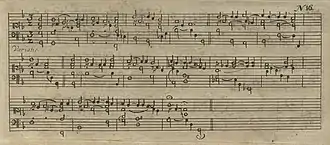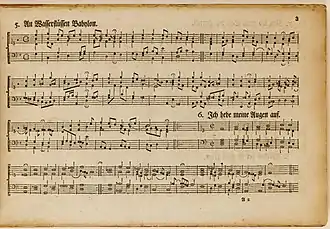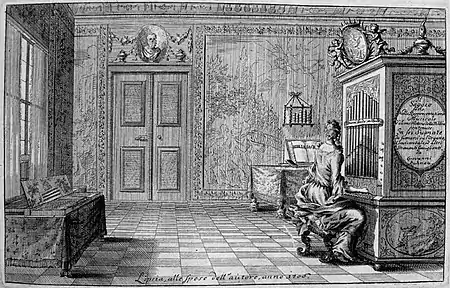Daniel Vetter
Daniel Vetter (b. 1657/1658, Breslau – 7 February 1721, Leipzig) was an organist and composer of the German Baroque era.[1]
.jpg.webp)
Life
Born in Breslau, Vetter became a pupil of Werner Fabricius in Leipzig. When Fabricius died in 1679, Vetter succeeded him as organist of the St. Nicholas Church.[2] Some time before 1695 he wrote a melody for Jakob Wilisius, who at the time was cantor in Breslau, and to whom he was befriended.[3] That hymn tune, Zahn No. 6634, was sung at the cantor's funeral in Breslau, in 1695.[3]

Vetter published the first volume of his Musicalische Kirch- und Hauß-Ergötzlichkeit in 1709.[4] From 1710 to 1716 he supervised the construction of the new organ built by Johann Scheibe in the church of the university of Leipzig, an organ that was tested in 1717 over a three-day period by Johann Sebastian Bach in Vetter's presence.[5][2][6] Meanwhile, the second volume of his Musicalische Kirch- und Hauß-Ergötzlichkeit was published in 1713.[7] It contained a four-part setting of the Zahn 6634 melody, to the text of Caspar Neumann's "Liebster Gott, wann werd ich sterben" hymn.[3] Vetter remained organist of St. Nicholas until his death in 1721.[2]
Works


Publications
Vetter published two volumes of Musicalische Kirch- und Hauß-Ergötzlichkeit (lit. 'Musical church- and home-delectation'):[1][2]
- The first volume, containing 130 four-part settings of hymn tunes was published In Leipzig in 1709, and reprinted in Dresden in 1716.[8][9][10]
- The second volume, containing 91 more settings of chorale melodies, was published in 1713.[11]
The collection contains settings of 117 hymn tunes: most melodies appear first in a setting for organ, followed by a more ornate setting for stringed keyboard instrument.[12] Apart from a volume containing seven pieces by Heinrich Buttstett (Musikalische Klavierkunst und Vorratskammer, 1713) it was the only keyboard music published in Leipzig in the first quarter of the 18th century.[13] Vetter's collection is a cross-over of settings for accompaniment of singing, and instrumental chorale preludes.[14]
Other compositions
Some of Vetter's compositions survive as manuscripts:
- Alleluja Christus von den Toten auferwecket for SSATB soloists and choir, and orchestra. Parts copied for a performance in Grimma in 1682.[15]
- Veni sancte spiritus à 14, for SSATB soloists and choir, strings, winds and organ. Parts copied for a performance in Grimma in 1682.[16]
- Ich will dem Herren singen so lang ich lebe, motet for double SATB choir, dedicated to Johann Schelle. The manuscript consists of vocal parts, copied in 1701, the year Schelle died.[17]
- Heut freue dich Christenheit, sacred concerto for voices, strings and organ, for the second Sunday of Advent. Copy of the score.[18]
Reception

Some of the settings from the second volume of Vetter's Musicalische Kirch- und Hauß-Ergötzlichkeit were adopted in Friedrich Wilhelm Birnstiel's first publication of four-part chorales by Johann Sebastian Bach (1765).[21][22] The sixth and last movement of Liebster Gott, wenn werd ich sterben? BWV 8, one of Bach's chorale cantatas, is a reworked version of Vetter's four-part setting of the hymn with the same name, with radical alterations, however close enough to Vetter's original to be marked as a work spuriously attributed to Bach in the 1998 edition of the Bach-Werke-Verzeichnis (BWV).[22][23][24][25][26]
| Vetter 1713 |
Title | Birnstiel 1765 |
BWV |
|---|---|---|---|
| 5 | O Traurigkeit, o Herzeleid | 18 | Anh. 204[27][28] |
| 20 | Ich hebe meine Augen auf | 6 | Anh. 203[20][29] |
| 29 | Gott hat das Evangelium | 31 | Anh. 202[30][31] |
| 35 | Du Friedefürst, Herr Jesu Christ | 15 | Anh. 201[32][33] |
| 91 | Liebster Gott, wann werd ich sterben | 47 | 8/6[34][35]alia |

Modern commentary on Vetter's chorales has varied. In the most recent version of Grove's Dictionary, Marshall (2002) states that: "Although these pieces have been severely criticized by modern writers as primitive, the appearance of a second part suggests they were popular in their time." The musicologist Peter Williams has compared settings of Vetter's with Bach's short chorale preludes from Orgelbüchlein, which date from exactly the same period: according to Williams, Vetter's treatments were "competent but jejune". As a specific comparison, Williams has taken the first chorale Nun komm der Heiden Heiland: for him Vetter's clavichord or spinet setting as a French prélude is less convincing then Bach's setting BWV 599; "the opening chorale’s expressive tmesis or semiquaver break in the melody of bar 1, imitated in the following alto and tenor, was the result of second thoughts—a tiny but clear example of creative thinking, and typical of the album." Writing from the perspective of Bach's biography, Williams suggests that "J. S. Bach wished to surpass Vetter in his own work."[36][37][38] Rose (2005) also compares the two treatments of Nun komm der Heiden Heiland by Vetter and Bach. He states that whereas "Bach makes the chord-breaking into a contrapuntal figure that pushes the texture forward and creates constant variety", Vetter's uniform and automatic resort to broken-chord figures is "astounding". As Rose comments, this predictability led Gotthold Frotscher in the 1930s to accuse Vetter of "lacking creative power" in these works.[39] Rose and Rathey (2010) have examined the anthology in the context of late seventeenth– and early eighteenth–century music-making and domestic worship in Germany: the chorales were aimed at the pious merchant class in Leipzig, with simple four-point settings for organ coupled with clavichord or spinet broken-chord settings in the fashionable luthé or brisé style. The preface to Vetter's second volume states that no great degree of proficiency was required for performers of his chorales; nevertheless, even the highly accomplished keyboard player Anna Amalia, the sister of Frederick the Great, had a copy of Vetter's chorales in her personal library.[40][41] Leaver (2017) outlines the relevance of Vetter's 1713 second preface in the role of Lutheran worship, where Vetter explains "the spiritual benefits of music, especially the practice of singing hymns after meals, and does so by reference to Luther." Leaver infers that Bach's use of Vetter's final chorale Liebster Gott for the 1724 cantata BWV 8, "implies that he had probably read Vetter’s preface referring to Luther."[42]
References
- Marshall 2002
- Seiffert, Max (1895), "Vetter, Daniel", Allgemeine Deutsche Biographie (ADB) (in German), 39, Leipzig: Duncker & Humblot, pp. 532–535
- Zahn 1891.
- Vetter 1985.
- Butler 2016.
- Universitätsgottesdienst: Geschichte at Leipzig University website.
- Killy & Vierhaus 2011.
- Musicalische Kirch- und Hauß-Ergötzlichkeit: Scores at the International Music Score Library Project
- Vetter 1709.
- Vetter 1716.
- Vetter 1713.
- Rose 2005, p. 39.
- Rose 2005, p. 40.
- Dirst 2012.
- RISM No. 211005363
- RISM No. 211005364
- RISM No. 211005365
- RISM No. 455034270
- An Wasserflüssen Babylon / Ein Lämmlein geht und trägt die Schuld BWV 267 at Bach Digital.
- Ich hebe meine Augen auf, BWV Anh. 203 / Anh. II 31→ at Bach Digital.
- Wachowski 1983, p. 55.
- Platen 1976.
- Dahn 2018.
- Dürr & Jones 2006, p. 553.
- Dürr & Kobayashi 1998, p. 468.
- Spitta 1899, II, pp. 431–432.
- O Traurigkeit, o Herzeleid, BWV Anh. 204 / Anh. II 31→ at Bach Digital.
- RISM No. 1001084323
- RISM No. 1001084269
- Gott hat das Evangelium, BWV Anh. 202 / Anh. II 31→ at Bach Digital.
- RISM No. 1001084359
- Du Friedefürst, Herr Jesu Christ, BWV Anh. 201 / Anh. II 31→ at Bach Digital.
- RISM No. 1001084320
- Dahn 2019.
- Liebster Gott, wenn werd ich sterben BWV 8/6 at Bach Digital.
- Williams 2003
- Williams 2014
- Williams 2016
- Rose 2005
- Rose 2005
- Rathey 2010
- Leaver 2017
Editions of Musicalische Kirch- und Hauß-Ergötzlichkeit
- Vetter, Daniel (1709). Musicalische Kirch- und Hauß-Ergötzlichkeit (in German). 1 (1st ed.). Leipzig: Christoph Friedrich Rumpff.
- Vetter, Daniel (1713). Musicalische Kirch- und Hauß-Ergötzlichkeit (in German). 2. Leipzig. OCLC 857536916.
- Vetter, Daniel (1716). Musicalische Kirch- und Hauß-Ergötzlichkeit (in German). 1 (2nd ed.). Dresden: Johann Christoph Zimmermann.
- Vetter, Daniel (1985) [1709–1713]. Musicalische Kirch- und Hauß-Ergötzlichkeit: Bestehend In denen gewöhnlichen Geistlichen Liedern, so durchs gantze Jahr bey öffentlichen Gottes-Dienst gesungen werden; auff eine gantz angenehme jedoch leichte Manier in Italienische Tabulatur gesetzt, so, daß allemahl der Choral eines jedweden Liedes auff der Orgel, nachgehends eine gebrochene Variation auff dem Spinett oder Clavicordio zu tractiren folget; mit sonderbahren Fleiß auffgesetzt (in German). I–II (facsimile ed.). Hildesheim: Georg Olms. ISBN 3-487-07509-1.
Bach Digital
- "An Wasserflüssen Babylon / Ein Lämmlein geht und trägt die Schuld BWV 267". Bach Digital. Leipzig: Bach Archive; et al. 2019-03-11.
- "Du Friedefürst, Herr Jesu Christ, BWV Anh. 201 / Anh. II 31→". Bach Digital. Leipzig: Bach Archive; et al. 2018-07-07.
- "Gott hat das Evangelium, BWV Anh. 202 / Anh. II 31→". Bach Digital. Leipzig: Bach Archive; et al. 2018-07-07.
- "Ich hebe meine Augen auf, BWV Anh. 203 / Anh. II 31→". Bach Digital. Leipzig: Bach Archive; et al. 2018-07-07.
- "Liebster Gott, wenn werd ich sterben [1st version] BWV 8.1". Bach Digital. Leipzig: Bach Archive; et al. 2020-04-08.
- "Liebster Gott, wenn werd ich sterben BWV 8/6". Bach Digital. Leipzig: Bach Archive; et al. 2019-05-22.
- "O Traurigkeit, o Herzeleid, BWV Anh. 204 / Anh. II 31→". Bach Digital. Leipzig: Bach Archive; et al. 2018-07-07.
By author
- Butler, Lynn Edwards (2016). Dirst, Matthew (ed.). "Bach's Report on Johann Scheibe's Organ for St. Paul's Church, Leipzig: A Reassessment". Bach Perspectives. University of Illinois Press. 10 (Bach and the Organ): 1–15. doi:10.5406/illinois/9780252040191.003.0001. ISBN 9780252040191. JSTOR 10.5406/j.ctt18j8xkb.5. LCCN 2015041912. OCLC 927141379.
- Dahn, Luke (2018). "So how many Bach four–part chorales are there?". www.bach-chorales.com.
- Dahn, Luke, ed. (2019). "BWV 8.6 (=BWV 8/6)". www.bach-chorales.com.
- Dirst, Matthew (2012). "Inventing the Bach chorale". Engaging Bach: The Keyboard Legacy from Marpurg to Mendelssohn. Cambridge University Press. pp. 41 and 43. doi:10.1017/CBO9781139027908.004. ISBN 9781139027908.
- Dürr, Alfred; Kobayashi, Yoshitake, eds. (1998). Bach Werke Verzeichnis: Kleine Ausgabe – Nach der von Wolfgang Schmieder vorgelegten 2. Ausgabe [Bach Works Catalogue: Small Edition – After Wolfgang Schmieder's 2nd edition] (in German). Kirsten Beißwenger (collaborator). (BWV2a ed.). Wiesbaden: Breitkopf & Härtel. ISBN 9783765102493. Preface in English and German.
- Dürr, Alfred; Jones, Richard D. P. (2006) [2005]. "Liebster Gott, wenn werd ich sterben, BWV 8". The Cantatas of J. S. Bach: With Their Librettos in German-English Parallel Text. Oxford University Press. pp. 550–553. ISBN 9780199297764.
- Killy, Walther; Vierhaus, Rudolf, eds. (2011). "Vetter, Daniel". Thibaut - Zycha. Dictionary of German Biography. 10. Walter de Gruyter. p. 208. ISBN 9783110961164.
- Marshall, Robert L. (2002). "Vetter, Daniel". Grove Music Online. Oxford University Press. doi:10.1093/gmo/9781561592630.article.29266.
- Platen, Emil (1976). "Zur Echtheit einiger Choralsätze Johann Sebastian Bachs" [On the authenticity of some of Johann Sebastian Bach's chorale settings]. In Schulze, Hans-Joachim; Wolff, Christoph (eds.). Bach-Jahrbuch 1975 [Bach Yearbook 1975]. Bach-Jahrbuch (in German). 61. Neue Bachgesellschaft. Berlin: Evangelische Verlagsanstalt. pp. 50–62. doi:10.13141/bjb.v1975.
- Rose, Stephen (1 February 2005). "Daniel Vetter and the Domestic Keyboard Chorale in Bach's Leipzig". Early Music. Oxford University Press. 33: 39–53. doi:10.1093/em/cah040. JSTOR 3519514.
- Spitta, Philipp (1899). Johann Sebastian Bach: His Work and Influence on the Music of Germany, 1685–1750. I – II – III. Translated by Bell, Clara; Fuller Maitland, John Alexander. Novello & Co.
- Wachowski, Gerd (1983). "Die vierstimmigen Choräle Johann Sebastian Bachs: Untersuchungen zu den Druckausgaben von 1765 bis 1932 und zur Frage der Authentizität" [The four-part chorales of Johann Sebastian Bach: research into the printed editions from 1765 to 1732 and regarding the question of authenticity]. In Schulze, Hans-Joachim; Wolff, Christoph (eds.). Bach-Jahrbuch 1983 [Bach Yearbook 1983]. Bach-Jahrbuch (in German). 69. Neue Bachgesellschaft. Berlin: Evangelische Verlagsanstalt. pp. 51–79. doi:10.13141/bjb.v1983. ISSN 0084-7682.
- Zahn, Johannes (1891). Die Melodien der deutschen evangelischen Kirchenlieder (in German). IV. Gütersloh: Bertelsmann. p. 130.
- Leaver, Robin A. (2017). Luther's Liturgical Music: Principles and Implications. Lutheran Quarterly Books. Fortress Press. p. 286. ISBN 9781506427164.
- Rathey, Markus (2010). "Buxtehude and the Dance of Death: The Chorale Partita Auf meinem lieben Gott (BuxWV 179) and the Ars Moriendi in the Seventeenth Century". Early Music History. Cambridge University Press. 29: 161–188. JSTOR 40800911.
- Williams, Peter (2003), The Organ Music of J. S. Bach (2nd ed.), Cambridge University Press, ISBN 0521891159
- Williams, Peter (2014). "Bach and the organ". The Musical Times. Musical Times Publications. 155 (1926): 81–94. JSTOR 24615706.
- Williams, Peter (2016). Bach: A Musical Biography. Cambridge University Press. ISBN 9781107139251.
- Yearsley, David (2019). Sex, Death, and Minuets: Anna Magdalena Bach and Her Musical Notebooks. New Material Histories of Music. University of Chicago Press. ISBN 9780226617848.
External links
- RISM No. pe30006751
- Birnstiel, Vol. 1 (1765) – facsimile at University of Bonn website.
- Scores by Daniel Vetter at the International Music Score Library Project (IMSLP)